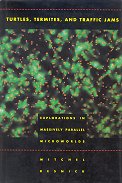Turtles, Termites, and Traffic Jams is a wide-ranging exploration into the counterintuitive world of decentralized systems and self-organizing phenomena. Increasingly, researchers are choosing decentralized models for the organizations and technologies they construct in the world, and for the theories they construct about the world. Yet many people continue to resist these ideas, assuming centralized control where none exists, and imposing centralized control where none is needed.
Drawing on ideas from computer science, education, psychology, and systems theory, Mitchel Resnick examines how and why people resist decentralized ideas, and he describes an innovative new computer language, called StarLogo, that he designed to help people {even young children) develop new ways of thinking about these ideas. For example, a student can use StarLogo to write simple rules for thousands of “artificial ants,” then observe the colony-level behaviors that arise from all of the interactions.
Resnick discusses how high-school students have used StarLogo to create new types of computer simulations, and he examines how their thinking changed in the process. He concludes by proposing heuristics for thinking about decentralized systems, aimed at helping people move beyond the centralized mindset.


